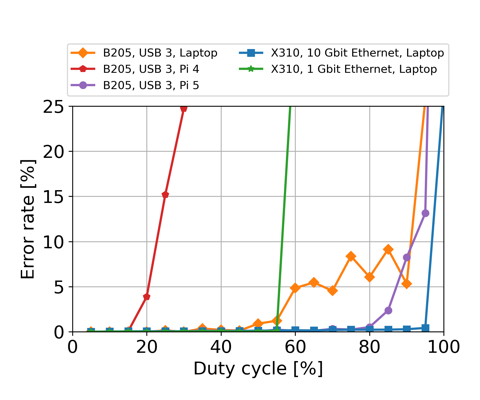Compatible hardware
Selecting a Software-Defined Radio (SDR)
ORCA is built upon the USRP Hardware Driver (UHD). As such, it is theoretically compatible with any Ettus SDR. We have primarily tested with B and X series devices (B205mini and X310, in particular), however most other Ettus SDRs should work with minor tweaks.
The basic capabilities of the two models we regularly use are detailed below:
| SDR | Frequency Range (GHz) | Bandwidth (MHz) | Channels | Mass (kg) | Approximate Cost (USD) |
|---|---|---|---|---|---|
| X310 with UBX160 | 0.01-6 | 200 | 2 TX, 2 RX | 1.7 | $14,0000 |
| B205mini-i | 0.07-6 | 56 | 1 TX, 1 RX | 0.024 | $1,600 |
In general, we recommend B series devices for applications with constraints on size, weight, power, or budget. When capabilities beyond the B series are needed, we recommend the X series.
If no device in either series suits your needs, consider other Ettus SDRs. Most should work with minor tweaks. The exception to note are E series devices, which include an embedded computer running Linux. In theory, this code could be run on that embedded computer, however the performance limitations would limit the use cases.
Host Computer
Unless you choose an E series device (see caution above), you will also need a computer to interface with the SDR. This computer is where the ORCA code will run.
The capabilities of the computer can make a significant difference in the system performance. The host computer must support an interface with enough bandwidth for the samples you want to transfer and be able to store these samples to an appropriate storage medium.
If you’re not resource constrained, a modern laptop will provide more than enough processing power, as long as it supports the interface you need. Keep in mind that X-series SDRs need a 10 gigabit ethernet (10 GigE) interface to achieve maximum sample rates. Few laptops natively support 10 GigE, however there are Thunderbolt adapters available. (Not all USB C ports support Thunderbolt and it may not be available on low-end laptops.)
For an embedded solution, Raspberry Pi’s are suitable for working with B series devices. The performance of the Raspberry Pi 5 greatly exceeds the Raspberry Pi 4, likely due to the introduction of a new USB interface chip.
Some caution is advised with other single-board computers. Their performance will likely be limited by their choice of USB controller chip.
For some examples of duty cycles achievable with various combinations of SDRs and host computers, see the figure below. Note that actual performance will depend on a variety of factors, including your exact configuration and the speed of your storage medium.

Example results from running error_code_late_command_sweep.py on several
combinations of host computers and SDRs.